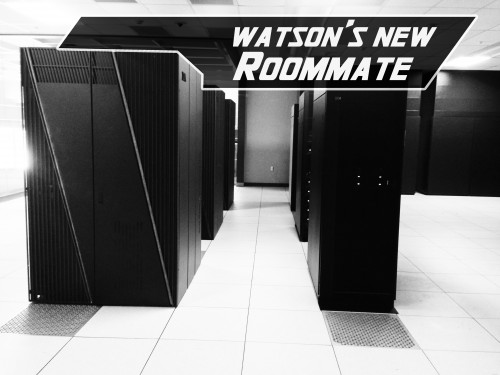 The Advanced Multiprocessing Optimized System comprises five racks of IBM’s Blue Gene/Q supercomputer. As a result, it is capable of performance reaching 1.1 petaflops.
The Advanced Multiprocessing Optimized System comprises five racks of IBM’s Blue Gene/Q supercomputer. As a result, it is capable of performance reaching 1.1 petaflops.On Thursday, October 3, President Shirley Ann Jackson announced that IBM Watson would be “getting a roommate.” This roommate, the Advanced Multiprocessing Optimized System, brings RPI into the petascale era of computing.
AMOS—whose name was devised by Co-Terminal student Ben Vreeland ’14—is a supercomputing system comprised of five racks of IBM’s Blue Gene/Q supercomputer. As a result, it is capable of a peak performance of 1.1 petaflops, which equates to 1.1 quadrillion calculations per second. To provide scale, this is approximately 150,000 calculations per second for every single individual on Earth. According to the Director of the Center for Computational Innovations—the name of the building was recently changed from the Computational Center for Nanotechnology Innovations—Christopher Carothers, AMOS is equipped with 17 processor cores. 16 of these are PowerPC A2 processors, while the 17th is devoted purely to maintaining the computer’s operating system. Carothers explained that this feature, among others, was one of the main reasons for AMOS’s computational power and efficiency. He added that AMOS’s networking capabilities utilize a bisection bandwidth of approximately four terabytes per second. This is more than the combined bandwidth of two million home broadband users.
According to Jackson, the computational power of AMOS places it among the top four in the United States, and among the top twelve such systems in the world. She added that AMOS is the top computing system in New York and the Northeast. It is also the top at any private education institution in the world. As such, “AMOS is a cornerstone for the Rensselaer Institute for Data Exploration and Applications,” said Jackson. Assistant Director of News and Editorial Services Michael Mullaney said, “The Rensselaer IDEA connects three of the university’s critical research platforms: the CCI supercomputing center (AMOS and the Watson at Rensselaer), the Curtis R. Priem Experimental Media and Performing Arts Center, and the Center for Biotechnology and Interdisciplinary Studies.”
Vice President for Information Services and Technology and Chief Information Officer John Kolb ’79 and Jackson mentioned that several members of RPI’s faculty have utilized the resources provided by AMOS for their research. These included Tetherless World Constellation members Jim Hendler and Deborah McGuinness; Head of the Department of Physics, Applied Physics, and Astronomy Angel E. Garcia; and Associate Professor of Computer Science Petros Drineas.
IBM Senior Vice President and Director of Research and member of the Board of Trustees John E. Kelly III explained that part of the reason IBM decided to provide RPI with both Watson and the five Blue Gene/Q racks that form AMOS is the long-standing partnership between the Institute and IBM. This partnership began around two decades ago with the donation of an IBM SP2 system. “We are extremely pleased to have Rensselaer as a deep partner and a long-standing partner,” Kelly said.
Kelly added that RPI’s “commitment to move at speed” was another deciding factor in their decision. “I’ve never seen another academic institution that moves at industrial speed,” he said. With the transition from high-performance computing to high performance analytics and the rise of Big Data, Kelly said this speed is critically important.
Carothers said that both graduate and undergraduate students have already begun to use both AMOS and Watson. He added that the Institute would begin to collaborate with industries to fully utilize the computing power the two systems provide.
Although RPI has just entered the petascale computing world, Carothers hopes to see RPI looking into the future of computing, particularly into the possibility of exascale supercomputers, which would process at 1,000 times the rate of systems like AMOS. “Rensselaer is not just ready to enter the petascale age, but to change the world for the better,” Carothers said.
For more information about Watson, AMOS, and the CCI, visit https://ccni.rpi.edu/.
